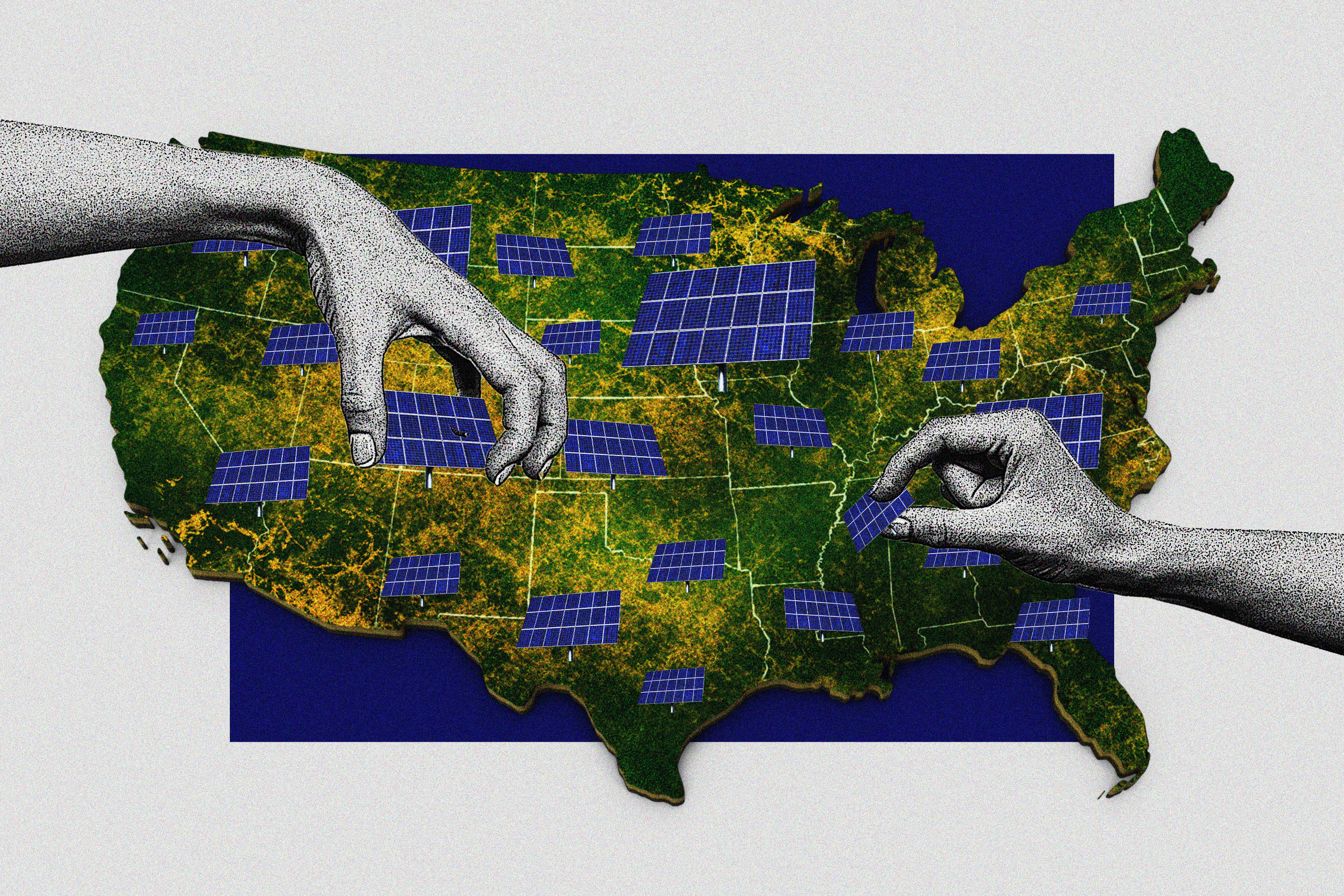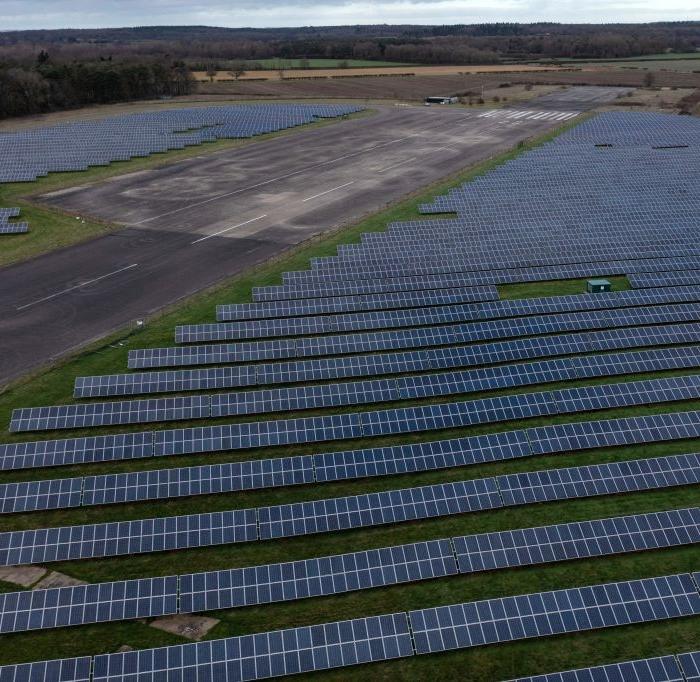Solar energy’s appetite for vast amounts of land has prompted the Biden administration to propose designating as much as 55 million acres of public lands as potential sites for industrial-scale solar farms.
That’s an area larger than 36 states and similar in size to Idaho or Minnesota.
In the most aggressive of these scenarios, 55 million acres across 11 Western states would be made available for solar energy. The least aggressive alternative would designate 8 million acres for that purpose.
The BLM’s “preferred alternative” falls halfway between the two, setting aside 22 million acres for solar development.
In total, the BLM manages 162 million acres of public land designated as “multi-use.” These multiple uses include farming, ranching, hunting and fishing, hiking and camping, drilling, and mining—and more recently, wind and solar installations and transmission lines to connect them to the grid.
The BLM, a division of the Department of the Interior, states that, in order to carry out the Biden administration’s goal of generating 25 gigawatts (GW) of electricity from wind and solar on public lands by 2025—and generating 100 percent “renewable” electricity by 2035—solar panels would need to be sited on 700,000 acres of public land.
More than 3 million solar panels are required to produce 1 GW of electricity, according to the Department of Energy. One GW can power 500,000 to 750,000 homes on average, assuming a constant supply of energy generation and use.
“And this updated solar roadmap will help us get there in more states and on more lands across the West,” she said.
“Our public lands are playing a critical role in the clean energy transition.”
The states targeted for solar development include Arizona, California, Colorado, Idaho, Montana, Nevada, New Mexico, Oregon, Utah, Washington, and Wyoming. This initiative is part of a wider effort to satiate the demand for land from solar companies.
The sheer scope of the BLM plan—designating tens of millions of acres for solar development when the agency says 700,000 acres would suffice to meet Biden administration goals—is a red flag for many communities.
Dylan Hoyt, the planning program manager in the Utah Public Lands policy coordinating office, calls it “bad optics.”
“When I say bad optics, I mean when you tell me that I have 17,000 acres in Utah that’s set aside for solar, and now we’re going to jump to 3.7 or 1.5 million,” he told The Epoch Times.
“That looks terrible.”
The article mentions Robert Moses, New York’s mid-20th-century unelected Parks and Recreation Commissioner, who was responsible for enormous urban planning projects including parks, bridges, and highways that crisscrossed the state.
Among Mr. Moses’s more notorious mega-projects were highway systems such as the Cross Bronx Expressway that ran through urban communities and turned once-vibrant neighborhoods into slums.

‘Destroying the Environment to Save It’
Some who are on the receiving end of the BLM’s solar plan say that, despite assurances from environmental groups, they remain concerned about the scale of this government development project and the amount of land that it would consume.“They say we have to protect the environment, but they’re OK with destroying the environment to save it,” Gabriella Hoffman, policy analyst and host of the “District of Conservation” podcast, told The Epoch Times. “It makes no sense if you’re a conservationist.”
“This idea that we can save the environment by carpeting the rural landscape with oceans of solar panels and forests of wind turbines—it boggles the mind how climate activists can justify this,” he told The Epoch Times.
“It’s definitely going to impact wildlife,” Mr. Hoyt said. And not only an impact on species that live in the designated solar zones but also on those that migrate through them.
“There’s definitely going to be conflicts with ranchers, there could be conflicts with access to public lands depending on where it’s built, and there could be potential conflicts with the mining industry,” he said.
“States didn’t really have a say in the goals in the first place, which I think is disconcerting because the states represent the citizens.”

From Multi-Use to Single-Use
One of the prime target states for solar development is Nevada, both because of the amount of sunlight it receives and because of its proximity to California and Las Vegas, with their ever-expanding demands for electricity.The federal government owns 85 percent of Nevada’s land, most of which is desert, but residents dispute the notion that it is devoid of wildlife and say they are concerned about the sheer scale of BLM’s solar plan.
“Nevada is hard-rock mining country,” Andy Rieber, a public lands consultant residing in Nevada, told The Epoch Times, “but the average footprint in Nevada for mining disturbance is less than 1,000 acres.

“Looking at the proposed solar developments in the state of Nevada, there are a few small ones, but most of them are running around 4,000 to 5,000 acres,” she said. “There’s one standout project that is a complex of seven contiguous facilities and would encompass approximately 62,000 acres, which is a lot of land.”
And while many climate activists wouldn’t shed a tear at the loss of mining, drilling, and cattle farming, local communities say they depend on them for food, energy, jobs, and tax revenue.
“With the oil and gas industry, there’s a royalty on everything that comes out of the ground, and a percentage of that ends up going back to the counties,” Mr. Hoyt said. “With solar, that doesn’t exist.”
“They come in, they build on federal lands, and they pay a permit fee to the Bureau of Land Management, but the local economy gets nothing,” he said.
While the BLM initiative touts “environmental justice” among its guiding principles, people in targeted states worry that poorer rural communities will feel the impact of solar development, but that the electricity produced will be delivered to wealthier urban centers in states such as California.
“Yes, we need to be considerate of environmental impacts,” Mr. Hoyt said. “But at the same time, we’re coming in and we’re putting a huge transmission line and a solar field, and then when it’s done those people still have it there and have to look at it and live with it, but they get nothing from it.”
Another issue that many cite with using multi-use public lands for solar is that solar energy crowds out other uses on the land.
“One of the things that is unique about solar development is that it doesn’t really play well with others,” Ms. Rieber said.
“If you have a grazing allotment, a lot of things can go on in and around that, including recreation, even mining,” she said. “But a large solar installation is going to take a big chunk of land out of multiple-use circulation because you can’t do anything else with it; it’s a singular use.”

Because utility-size solar installations such as the ones contemplated by BLM blanket entire areas with solar panels, often wiping out the vegetation and wildlife in those areas, both above ground and beneath it, they often displace farming, grazing, hunting, and recreation, while also preventing drilling and mining.
“We always try to have multiple use and sustained yield since 1976; that’s what Congress told us to do,” Mr. Hoyt said. That was the year that the Federal Land Policy and Management Act was passed, specifying how federal multi-use lands were to be administered.
An Alternative Proposal
In response to the BLM’s solar plans, several agencies in western states have developed their own proposal, called “Smart from the Start.”The idea behind it is essentially to limit solar development to so-called brownfield sites, such as closed landfills, superfund sites, and shuttered mines.
This plan provides a more specific definition of “disturbed lands” and would limit solar development to disturbed lands and “low conflict lands,” and would exclude wildlife habitats and migration corridors, locations near farms or residential areas, and lands that are in use for farming, ranching, tourism, recreation, or industry.
“I think it actually creates a template for locating solar in the most reasonable areas that would preserve habitat,” Ms. Rieber said. “That represents good planning, smart planning.”
So far, however, “the BLM has decided not to carry this alternative forward,” she said. “I would say that this is a very disappointing reaction.”
According to the BLM’s Western Solar Plan, the Smart From the Start alternative was dismissed as “substantially similar” to terms already in the BLM plan.
But state officials say there are substantial differences, arguing that Smart From the Start offers more precise criteria of what land should qualify for development, and that it would make far less land available for development than the BLM’s preferred alternative of 22 million acres.
The Epoch Times reached out to the BLM to comment on this and other issues regarding its Western Solar Plan. The BLM responded with links to fact sheets and the plan, but declined an interview.

Local officials say that plans for energy development must include not only a diverse array of energy sources but also a significant portion of “base load” energy, such as nuclear, gas, and coal, that can be ramped up and down as needed to balance out weather-dependent sources like wind and solar. And they say that needs to be done while minimizing the impact on public lands.
“Utah doesn’t have a lot of oil, but we do have pretty phenomenal geothermal resources,” Mr. Hoyt said. “A geothermal plant that could power the same amount of energy as a solar field that maybe takes up 640 acres, might take somewhere around 40 acres, so it’s a significantly smaller impact.”
Environmental Impact
Recently, some who have long backed the wind and solar industries in the hopes of reducing global temperatures appear to be also growing concerned about the environmental impact of these technologies.Environmentalists said this section of the Mojave Desert was home to vegetation such as 1,000-year-old woodlands that captured carbon from the atmosphere and sequestered it in root systems underground. Residents spoke of dust storms that cause respiratory problems, as local vegetation that had held soil in place was destroyed.
Ms. Rieber points to what she calls a “special convergence” among various interest groups across the political spectrum, from hunters and farmers to conservationists, who will feel the impact of solar development.

Public Comment Period
The BLM reports that it has, as of December 2022, permitted more than 9 GW of solar energy development, 3 GW of wind energy development, and 1.6 GW of geothermal energy development on public lands. The BLM has also permitted 17 transmission lines, crossing BLM-administered lands, to connect these facilities into the electric grid.“You too can weigh in; you don’t need to be a policy analyst, you can be a regular citizen,” Ms. Hoffman said. “This is what these comment periods are for; you can just write a sentence, simple as that.”
Meanwhile, public officials believe there’s a way to allow solar development that will be acceptable to local communities.
“The question on the table isn’t whether solar is good or bad; I think everyone ascertains that there is a place for it,” Ms. Rieber said. “The question on the table, rather, is let us proceed with this development in a way that we won’t regret in the future.”
Mr. Hoyt said that if the BLM proceeds with the Western Solar Plan as currently written, lawsuits will likely be the result.
“We don’t want to see litigation around solar development,” he said. “We have great relationships in Utah with our BLM employees, and we want to keep it that way.”
















